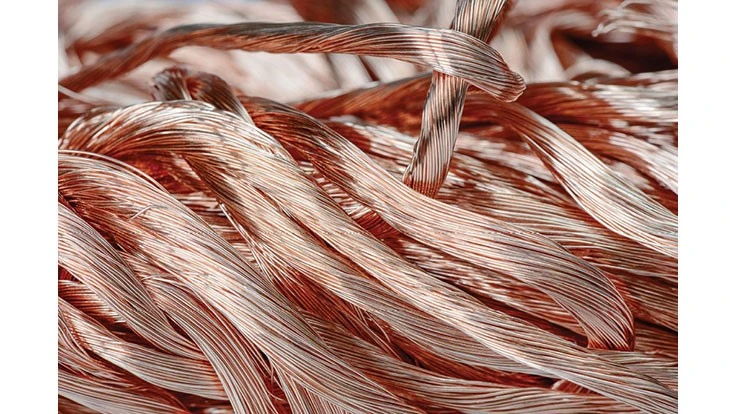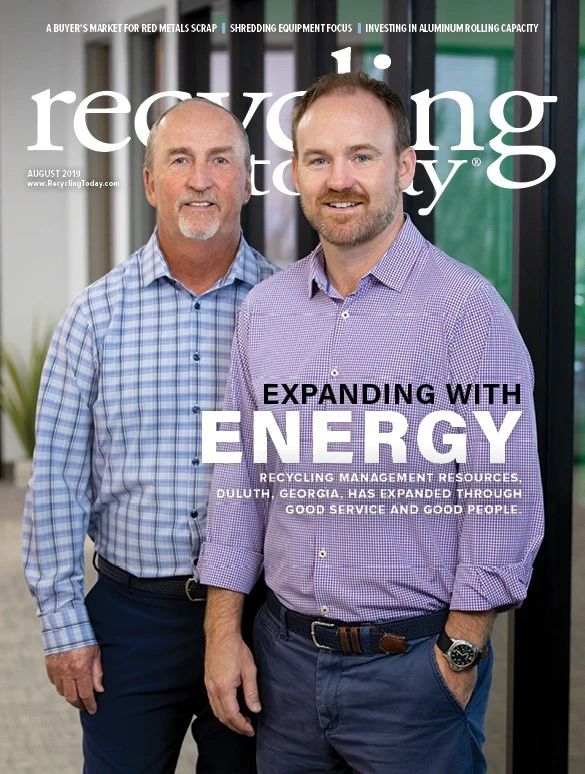

Even Randy Goodman, executive vice president of scrap brokerage firm Greenland (America) Inc., Roswell, Georgia, who describes himself as a “cockeyed optimist,” says he finds little reason for optimism when it comes to red metal scrap markets, which have been struggling with an imbalance between supply and demand for much of 2019. However, two other industry sources say they remain optimistic about the future of red metals. A Midwest-based broker who specializes in trading copper scrap domestically says he’s “cautiously optimistic” regarding the second half of the year.
Brian Shine, president of copper scrap processor Manitoba Corp., Lancaster, New York, and the current chair of the Institute of Scrap Recycling Industries (ISRI), Washington, says it’s not necessarily realistic to expect much improvement in red metals markets before the end of the year. However, he says he believes the future holds positive developments for copper, pointing to growth forecasts for electric vehicles and copper’s use in the medical field.
While that might be the case, brokers and scrap processors must currently deal with soft demand and excess supply.
Little movement
“2018 was incredibly stable from beginning to end,” Shine says of copper scrap markets. That has not been the case in 2019, he adds, explaining that his company has either been “chasing supply or chasing sales.”
As of mid-July, however, “Supply is dominating and demand is waning,” Shine says. He adds that he’s not sure whether to attribute the situation to the ongoing trade war with China or the typical summer doldrums.
Manitoba Corp. had its best month in May in terms of pounds shipped, Shine says. However, June “was the worst,” he adds.
“There is a large amount of supply out there,” Goodman says. “But, at the same time, there is a limited amount of consumption on certain grades of red metals, mostly No. 2 copper, but it also leaks into the other grades of copper and the brasses.”
The Midwest-based broker says, “The need to buy or sell is not too great on either side of the equation.”
Goodman says he sees the same reticence among red metal scrap sellers. “As much as they can hold out, they are trying to. But at the same time, they still have to generate cash flow,” he says.
“There are still sales to be had,” Shine says. However, he adds that the spot market is “very quiet.”
The broker says consumers have become more discerning given the amount of scrap available. “Consumers have increased what they are looking for in terms of quality.”
Goodman agrees that consumer are pickier now because they can be. He says, “They are being offered such tremendous amounts of material, they can look for what they want and pay somewhat accordingly.
“Although the sellers would like to be able to flex and hold or not sell or continue to move it around, at the end of the day, there is just a certain amount of consumption available, a certain amount of production available,” Goodman continues.
Scrap consumers are “pushing back on chops and things like that,” the broker based in the Midwest says. “It’s been trending in that direction, but now it is more apparent.”
The broker says an overabundance of No. 2 copper chops is available because a number of scrap yards have added wire chopping lines to be less dependent on export markets for insulated copper wire and to better control their recovery. “Everyone has a chopper now,” he says. “It’s the new [auto] shredder.”
Goodman says these processors have “pushed the boulder halfway up the hill because they have taken the processing a couple of steps further by getting it into a chop, but there are simply not enough homes for the material that they are generating right now. China has been a good home for No. 2 up until recently but has never been a good home for No. 2 chops.”
Consumers are not particular fans of No. 2 copper chops because “they are not as easy to handle as pure wire or busbar,” the Midwest-based broker says, adding that their yields also tend to be lower than similar material.
Goodman says that when it comes to Chinese consumers in particular, “No one is really sure why” they have not been regular consumers of No. 2 copper chops. He speculates that it could be their melting technology or the way they input the material that makes chops less desirable.
European refiners often end up with lower recovery than expected on No. 2 copper chops in Goodman’s experience. “But those homes are also apparently full at this point with delivery schedules out to September and October right now,” he says.
“There is not a lot of demand competition worldwide, and North American buyers fill up quickly,” Shine says.
He says Manitoba’s copper scrap packages generally have been too expensive to garner much interest from overseas buyers, particularly those in Asia. However, now that China no longer accepts low-grade material for import into the country, red metals consumers there might have to purchase higher grade material, Shine speculates.
China’s changing tone
According to a July 10 article by Fastmarkets AMM, “The Chinese central government has toned down its ambitious plan to ban all solid waste imports, including metal scrap, by the end of 2020 in its recently proposed revisions to the regulation on solid waste management.”
According to the revision proposed July 5 to Article 25 of the Law of the People’s Republic of China on the Prevention and Control of Environmental Pollution by Solid Waste, the country’s State Council will “achieve the target of the zero solid waste import step by step.”
AMM notes, “The revision differs from the proposal in July 2018, in which article 29 stipulates a ‘ban of solid waste imports.’”
Copper pricing*
June 2019
$5,867.50
Feb. 2019
$6,277.33
Oct. 2018
$6,214.57
June 2018
$6,953.55
*Average monthly settlement price, cash buyer, U.S. dollars per metric ton; source: London Metal Exchange, www.lme.com
China’s proposed ban on scrap imports led the country’s copper scrap industry “to mull discarding the term ‘scrap’ by officially renaming certain copper scrap products as ‘recyclable copper raw materials’ to reflect the high purity of the furnace-ready feed,” AMM reports.
“Short term, China is in the process of migrating definitions of certain commodity grades from being scrap or waste to raw material,” Goodman says. “No. 2 copper is now being looked at in a different light; furnace-ready material is starting to be looked at as raw material.”
Goodman says this could open more opportunities for U.S. processors to ship copper and brass scrap to China as long as the scrap is perceived to be furnace-ready material by the country’s customs officials.
“The caveat is that people must understand that this is not the China of one year ago let alone three or five years ago,” he says. “It is not the China that takes honey with all kinds of attachments.”
China also recently issued a second batch of scrap metal import quotas for delivery in the third quarter, according to a report from Argus Media, totaling nearly 437,000 metric tons.
China Solid Waste and Chemicals Management, a Chinese environmental ministry division, approved 124,450 metric tons of copper scrap, 306,930 metric tons of aluminum scrap and 5,500 metric tons of ferrous scrap for delivery to ports in south, southeast and north China, the Argus Media article notes.
The first batch of quotas for import in the third quarter was issued in June. More than 240,400 metric tons of copper, 54,250 metric tons aluminum and 14,970 metric tons of ferrous scrap were permitted for import at that time.
Regarding total import quotas for the third quarter, Argus Media notes, “The copper quota is below volumes of copper scrap imported in the third quarter of 2018. By contrast, the aluminum quota has already exceeded the deliveries in the same quarter last year.”
“China is still a viable home for certain commodities,” Goodman says. “You have to have trusted partners there who understand how to work within the new regime—not step around certain issues.”
He adds that even if the trade war between the United States and China is resolved soon, China will never again purchase the material it used to purchase for import. “Material has to be processed further in the U.S. or shipped to areas that can process it with the blessings of their government,” Goodman says.
Looking to Europe
Overseas homes for red metal scrap include India, while on the smaller side, Pakistan, Malaysia, Korea, Japan and Europe, Goodman says. However, he believes more copper smelting capacity is needed globally.
How Hamburg, Germany-based Aurubis AG’s acquisition of the Belgian-Spanish Metallo Group and the purchase of Global Brass and Copper, Schaumburg, Illinois, by the Wieland Group, Ulm, Germany, will affect red metals markets remains to be seen.
Global Brass and Copper Holdings is a converter, fabricator, processor and distributor of specialized nonferrous products, including a wide range of sheet, strip, foil, rod, tube and fabricated metal component products. The company specializes in processing copper and copper alloys but also rerolls and forms other metals, such as stainless steel, carbon steel and aluminum. It uses scrap, virgin metals and other refined metals to melt, cast, roll, draw, extrude, weld and stamp to fabricate finished and semifinished alloy products. It operates under the Olin Brass, Chase Brass and A.J. Oster brand names in North America.
Global Brass and Copper is now a wholly owned subsidiary of Wieland Group, a supplier of semifinished copper and copper alloy products.
According to Aurubis, “The acquisition of Metallo, with its attractive growth potential, strengthens Aurubis’ metal portfolio, especially in the key metals copper, nickel, tin, zinc and lead. The Metallo Group complements the investment project Future Complex Metallurgy (FCM), with which Aurubis will process a higher volume of complex input materials.”
“From my understanding, Metallo has been on the market for the better part of a decade, off and on,” Goodman says. “There have been rumors of them having been bought by Aurubis” for a number of years.
Goodman says he believes Aurubis “will be able to make more intelligent decisions [regarding scrap purchasing] because they control more of the marketplace.” However, he adds, “I really don’t think they are long-term, huge, viable consumers of No. 2 copper from the United States because the United States is used to a higher premium or lower spreads.
“Their business is based on recoveries and assays and analysis, and U.S. suppliers typically want to sell as is to where is and aren’t willing to wait 30-to-40 days to get analysis,” Goodman continues. “And it’s overseas, so it’s very hard to complain about what their assays are.”
European refineries’ numbers in general tend to come out lower than what a traditional No. 2 copper smelter might assess the material at, Goodman explains. “They are in the business of refining. They are looking for the precious metals and all the goodies that come out when you process No. 2 copper in a refinery or in an electrolytic process of some sort to separate the copper from the goodies,” such as precious metals.
If U.S. red metals suppliers are looking for good news coming out of Europe as a result of these transactions, it remains uncertain that that will be the case as of now.

Explore the August 2019 Issue
Check out more from this issue and find your next story to read.
Latest from Recycling Today
- Nucor receives West Virginia funding assist
- Ferrous market ends 2024 in familiar rut
- Aqua Metals secures $1.5M loan, reports operational strides
- AF&PA urges veto of NY bill
- Aluminum Association includes recycling among 2025 policy priorities
- AISI applauds waterways spending bill
- Lux Research questions hydrogen’s transportation role
- Sonoco selling thermoformed, flexible packaging business to Toppan for $1.8B





